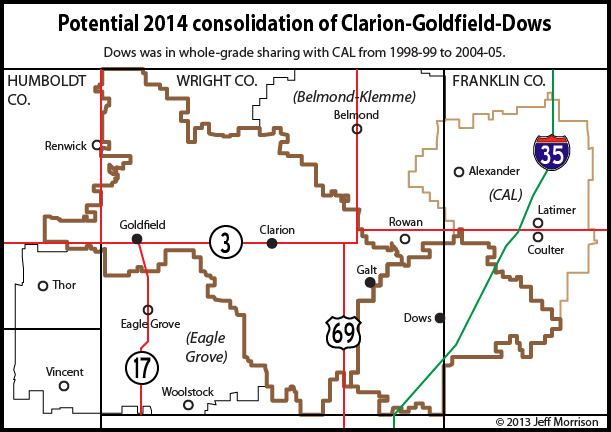
July 7, 2011: Brickwork detail on Dows’ original school building. It may not live to see its 103rd birthday.
Dows hasn’t had its own high school since the late 1990s, when it entered into a grade-sharing agreement with northeastern neighbor CAL. It wasn’t long before continued declining enrollment had both districts studying options. They together looked toward Hampton-Dumont, to the east, but then Dows alone also looked north, to Belmond-Klemme. Southeast of Dows is Alden, but it was already in a whole-grade sharing agreement with Iowa Falls, ruling out talks there. Finally, Dows settled on a one-way deal with Clarion-Goldfield.
In 2004, Dows school board president Shelly Howard told the Mason City Globe-Gazette, “We’re the small fish in the pond and if we merge, we’re the first ones to shut our doors.”
A decade later, the small fish has run out of places to swim. A consolidation vote between Dows and Clarion-Goldfield is scheduled for next week. Approval would create the 12th-largest consolidated district in the state by area, half a square mile bigger than Van Buren.

Clarion-Goldfield doesn’t mince words when it outlines the plan (PDF). All students will attend class in Clarion, a change from not that long ago when Goldfield was still used as an elementary. Dows already only has grades K-3 in the 99-year-old building photographed above. If the new school district can’t find any use for the Dows building in two years, it will be destroyed save for the gym and multi-purpose room.
The plan would be to incorporate Dows into the name, a fact the newsletter points out likely would not happen in the case of a dissolution. Many in the area are familiar with what happened to Boone Valley of Renwick, one of only two voluntary dissolutions in Iowa between 1965 and 2004. That story made it all the way to the Los Angeles Times in the greater context of the farm crisis.
Wright County is southeast of Kossuth County, whose population and enrollment declines I have gone over in detail. The circumstances and effects apply here as well. Wright County lost more than 3,000 people between 1980 and 2010, around a fifth of the total population.
